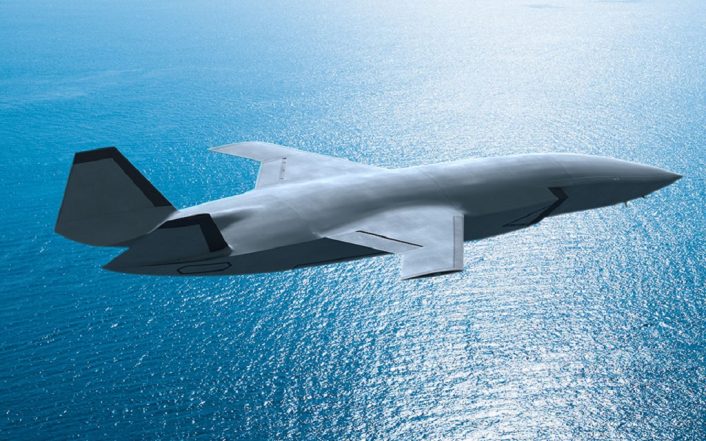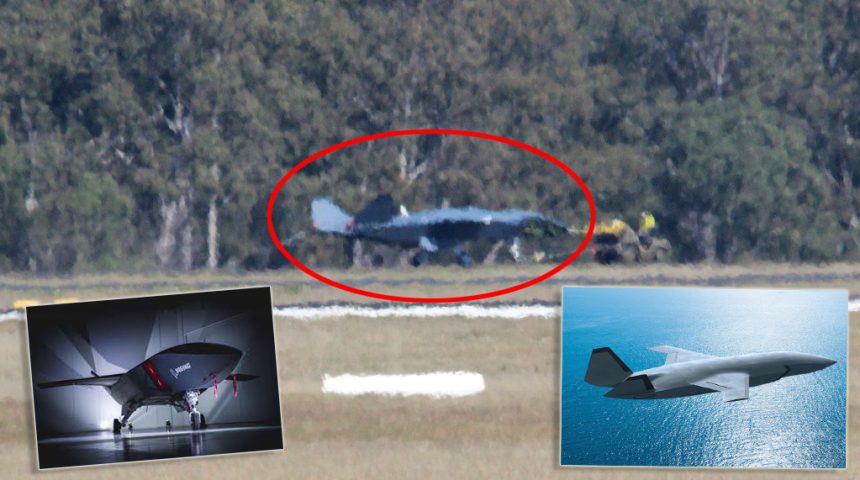The aircraft, part of the Loyal Wingman Advanced Development Program of the Royal Australian Air Force, is slated to fly for the first time before the end of 2020.
The Airpower Teaming System (ATS) unmanned aircraft, developed for the Loyal Wingman Advanced Development Program of the Royal Australian Air Force (RAAF) by Boeing Australia, has been sighted in the open while undergoing ground testing in preparation for the taxi trials. The photos were posted by Australian Defence Magazine on August 17, 2020, and reportedly taken a few days prior with long lenses by local sources in Queensland.
Boeing has been tight-lipped about giving info about the location where the first three aircraft are being built and also there are no photos other than the ones published by the company in occasion of the roll-out.
Australian Defence Magazine assessed that the airfield where the photos were taken could be RAAF Base Amberley, which is located 40 kms south-west of Brisbane, home of Boeing Australia. Amberley is the RAAF’s largest base and it hosts, among all units, the F/A-18F Super Hornet and EA-18G Growler fleets. The magazine quoted also a Boeing spokesperson which said that “the first ATS aircraft is currently undergoing ground testing, which will be followed by taxi and first flight later this year.”
Here are the long lens photos of Boeing’s autonomous Loyal Wingman aircraft, spotted out in the open for the first time. Full story – https://t.co/L9Ut8aVUax pic.twitter.com/fj8QDsA25C
— Aus Defence Magazine (@austdefence) August 17, 2020
This was also confirmed by Air Marshal Mel Hupfeld, Chief of the Royal Australian Air Force, in the Australian Aviation Podcast last month, saying “[the Loyal Wingman] would be undergoing some ground trial shortly and soon we hope we will take if for its first flight.”
Air Marshal Hupfeld noted that the RAAF is working on the policies to understand the discipline that an airman should apply to a system like the Loyal Wingman, highlighting that this is one of the key points of the program: ”The heart of it is about the systems that are inside that platform. The artificial intelligence that we will start to put into there, the opportunity to program algorithms that allow it to do what we call manned and unmanned teaming”.
The policy discussions are also focused on a modern strategic environment to determine how the aircraft will behave in operational situations: “Being able to pull that in, how does the platform behave? And what’s the brain in the platform that allows it to do all that and analyze all that information? And then when it’s told when it’s the right time to be able to move forward and engage with an adversary, whether that’s just through other means, short of conflict, and then, of course, at the higher-end if it was required, to be able to shoot a weapon”.

As we wrote in occasion of the roll-out, this drone is the first clean-sheet design created by Boeing outside the United States and also the first RAAF’s clean-sheet design in more than 50 years. The project, which involved several Australian companies, used new development techniques, like the “digital twin” concept, and new automated production systems.
One of the key features of the ATS is an 8.5 ft (2.6 m) long modular nose cone with 9000 cubic inches internal volume to house different payloads, which can be entirely swapped quickly according to the mission’s needs.
A similar AI-based program, called Skyborg Vanguard Program, is also in development by the U.S. Air Force and the Air Force Research Laboratory (AFRL). Skyborg is described as “an autonomy-focused capability that will enable the Air Force to operate and sustain low-cost, teamed aircraft that can thwart adversaries with quick, decisive actions in contested environments.”
Continuing our countdown to the release anniversary of the @usairforce Science and Technology Strategy for 2030, let’s celebrate one of the #AFVanguards, SKYBORG!
Read more on this game changing tech: https://t.co/q4uqPisNlN#AFResearchLab #SKYBORG #FutureTech pic.twitter.com/L3DGRbfX7d
— Air Force Research Lab – AFRL (@AFResearchLab) April 11, 2020
The system’s functioning looks similar to the Boeing ATS: “Military pilots receive key information about their surroundings when teamed aircraft with integrated autonomy detect potential air and ground threats, determine threat proximity, analyze imminent danger, and identify suitable options for striking or evading enemy aircraft. Embedded within the teamed aircraft, complex algorithms and cutting-edge sensors enable the autonomy to make decisions based on established rules of engagement set by manned teammates. Field tests will ensure the algorithms’ accuracy and verify that the system continuously operates within the constraints established during mission planning.”
For a quick comparison, the ATS will be flown by Artificial Intelligence (AI) and controlled from the back seat of a Super Hornet or a Growler for smaller formations, or from a control station aboard a Wedgetail or a Poseidon. Boeing didn’t provide details on how the AI specifically works, but explained that the controller will simply signal the mission intent to the Loyal Wingman and the AI will figure out by itself mission specifics and navigation, while keeping a safe separation from other manned and unmanned aircraft.
Boeing plans to submit a variant of ATS for Skyborg. Other companies competing in the program are Northrop Grumman, General Atomics and Kratos.









